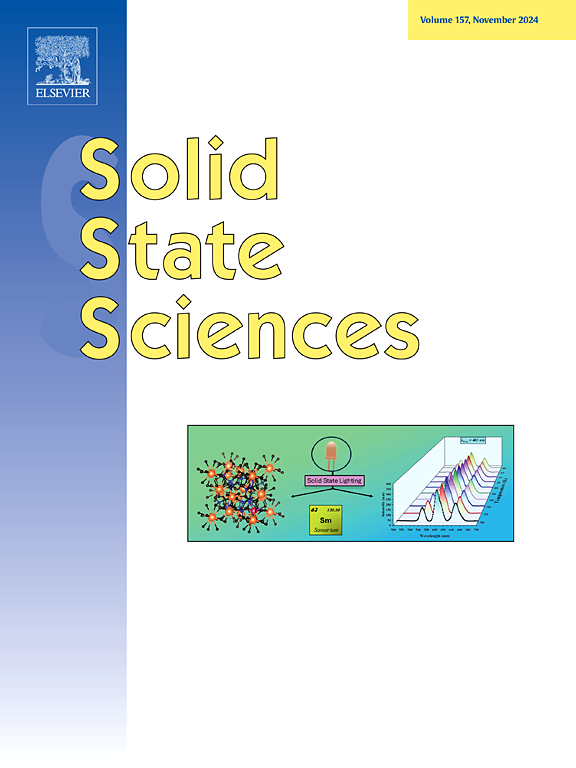Periodic trend of transition metals in the activity of 2D/2D MoS2/g-C3N4 nanohybrids in the HER and OER
IF 3.3
3区 化学
Q2 CHEMISTRY, INORGANIC & NUCLEAR
引用次数: 0
Abstract
This work presents a novel method for preparing nanohybrids by adding previously synthesized graphitic carbon nitride g-C3N4 nanosheets to an aqueous solution of ammonium thiomolybdate (NH4)2MoS4 which was synthesized in ammonia solution to form MoS2/g-C3N4 (2D/2D) interlayered nanostructured hybrid material. This approach increases the activity of MoS2 since its electronic structure, featuring “d” orbitals, allows the generation of active sites at the Mo edges for H+, OH−, −OOH, and O−2 adsorption, thus making it a highly efficient catalyst in chemical and electrochemical reactions. The interaction of g-C3N4 nanosheets with the MoS2 was determined by NMR and XPS, leading to a disorder in the MoS2 crystalline structure as shown from XRD, and therefore increasing the number of unsaturated sites S-Mo-S and 1T-MoS2 phase formation, as shown in Raman spectra. Additionally, incorporating transition metals such as Ni, Co, and Fe opens a new promising scenario to evaluate their electrochemical effect in the nanohybrid that enhances the availability of active sites during the HER and OER. In this context, NiMoSCN electrocatalyst is the most effective for HER whereas CoMoSCN is for OER. At the current rate of 10 mA/cm2, the overpotential of CoMoSCN decreases by up to 50 % with respect to the MoSCN.

过渡金属在HER和OER中2D/2D MoS2/g-C3N4纳米杂化物活性的周期变化趋势
本文提出了一种制备纳米杂化材料的新方法,即在氨溶液中合成的硫钼酸铵(NH4)2MoS4水溶液中加入先前合成的石墨化氮化碳g-C3N4纳米片,形成MoS2/g-C3N4 (2D/2D)层间纳米杂化材料。这种方法提高了MoS2的活性,因为它的电子结构具有“d”轨道,允许在Mo边缘产生H+, OH−,−OOH和O−2吸附的活性位点,从而使其成为化学和电化学反应中的高效催化剂。通过NMR和XPS测定了g-C3N4纳米片与MoS2的相互作用,导致XRD显示的MoS2晶体结构紊乱,从而增加了拉曼光谱显示的S-Mo-S和1T-MoS2相形成的不饱和位点的数量。此外,加入过渡金属,如Ni, Co和Fe,为评估其在纳米杂化材料中的电化学作用开辟了一个新的前景,以提高HER和OER过程中活性位点的可用性。在这种情况下,NiMoSCN电催化剂对HER最有效,而CoMoSCN电催化剂对OER最有效。在电流速率为10 mA/cm2时,CoMoSCN的过电位相对于MoSCN降低高达50%。
本文章由计算机程序翻译,如有差异,请以英文原文为准。
求助全文
约1分钟内获得全文
求助全文
来源期刊

Solid State Sciences
化学-无机化学与核化学
CiteScore
6.60
自引率
2.90%
发文量
214
审稿时长
27 days
期刊介绍:
Solid State Sciences is the journal for researchers from the broad solid state chemistry and physics community. It publishes key articles on all aspects of solid state synthesis, structure-property relationships, theory and functionalities, in relation with experiments.
Key topics for stand-alone papers and special issues:
-Novel ways of synthesis, inorganic functional materials, including porous and glassy materials, hybrid organic-inorganic compounds and nanomaterials
-Physical properties, emphasizing but not limited to the electrical, magnetical and optical features
-Materials related to information technology and energy and environmental sciences.
The journal publishes feature articles from experts in the field upon invitation.
Solid State Sciences - your gateway to energy-related materials.
 求助内容:
求助内容: 应助结果提醒方式:
应助结果提醒方式:


